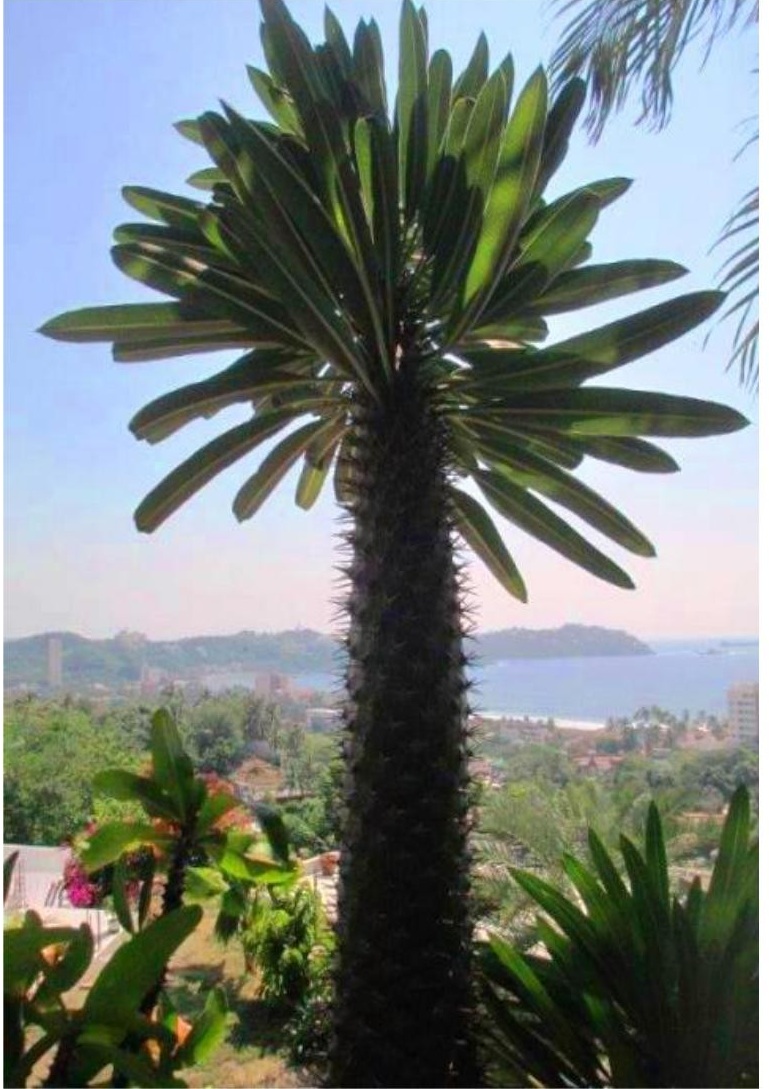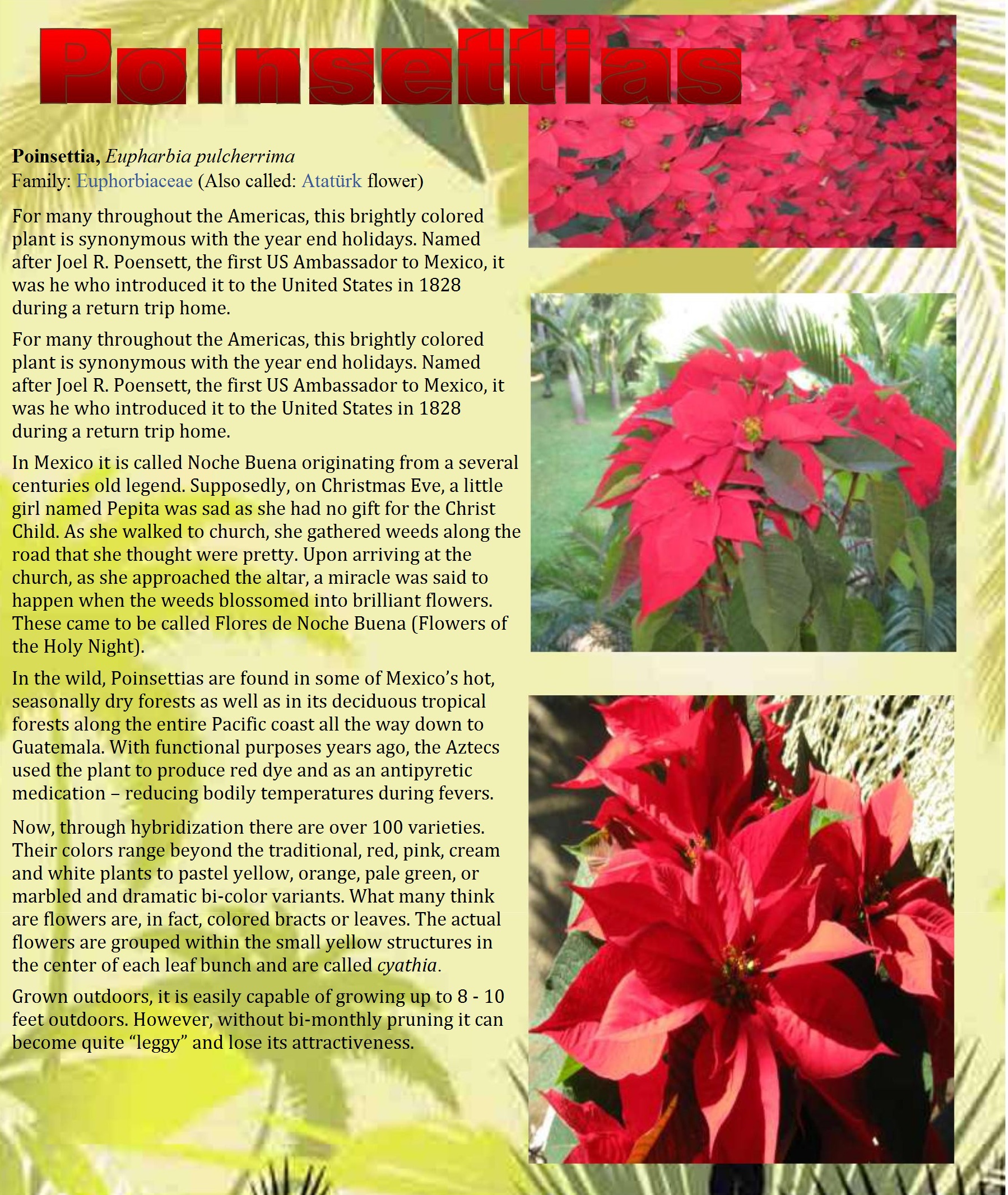By Tommy Clarkson on the February 2021 Edition
Identifying Palm Species
With well over 2,400 different species of palm trees known to exist, it’s no wonder that some folks become a bit confused when trying to determine the type they see or seek. But, in endeavoring to do so, it will help if you keep in mind that there are four basic differences you should consider when trying to identify palm varieties.
(By the way, from the very outset, I wish to thank the Food and Agriculture Organization of the United Nations which in addition to my numerous “stand by authority” botanical books was a major contributor of information accumulated for this article.)
Those four, somewhat easily noted, differences between palm species are as follows:
Trunk Type
There are five basic trunk variations: solitary, clustering, aerial branching, subterranean branching and climbing. However, it is important to keep in mind that the first two types are not mutually exclusive. And to confuse the issue a bit more, in some cases, a species may exhibit a proclivity to be both solitary and clustering sort!
- The solitary trunk growth habit is one of the two most com-mon among palm species and these are among the most generally cultivated for ornamental and economic purposes. However, there is a substantive difference in both the height and diameter of solitary palms. (For example, the Potato-chip Palm (Chamaedorea tuerckheimii) has a stem not even as large as a pencil and may not even reach a foot (30 cm) in height. At the other and of the spectrum is the Andean Wax Palm (Ceroxylon alpinum) which can grow as tall as 197 feet (60.05 meters). Often seen examples of solitary palms are the Coconut, Christmas (Manila), Cuban Royale, Bismark, Latan, Mexican, Desert and Chinese Fan Palms and Foxtail Palms. (Yes, all grow here in Ola Brisa Gardens!)
- Growing from a common root system, the clustering or multiple stemmed palms are the second most common types generally seen. They spread via suckers (basal off-shoots) at, or below, ground level. The more dense variants form themselves into thicket-like bunches. Two easily recognizable examples of these are the small, slow growing (often used indoors) Parlor Palm (Chamaedorea elegans) or the larger, attractive Butterfly Palm (Dypsis lutescens).
- More unusual are palms of the aerial branching type. Generally speaking, these are only found naturally in palms of the Hyphaene and Dypsis, Rattan Calamus, Korthalsia and Laccosperma generas. (As an interesting aside, damage caused by insects or a physical act such as lightning can cause aerial branching in solitary palms yet, no human technique has yet been determined to induce this.)
- About 600 species of palms in 15 genera are climbing palms. The source of virtually all commercial rattan, the genus Calamus (comprised of 350 different species and the largest genus in the palm family) is a great example of this type. The majority of climbing palms are also of the clumping nature.
- Lastly, there are those that do subterranean branching. This kind occurs in two ways: through dichotomous branching as found in the Nipa Palm (Nypa fruticans) or lateral branching like does the Salak Oalm (Salacca zalacca).Leaf (Frond) Composition
Endeavoring to apply the old “keep it simple stupid” rule, there are four basic palm frond types. By far and away, the most prevalent of these are the pinnate and palmate.
Endeavoring to apply the old “keep it simple stupid” rule, there are four basic palm frond types. By far and away, the most prevalent of these are the pinnate and palmate.
All four are as follows:
-
- Pinnate are the most commonly found type. These are divided into leaflets attached to the rachis of the frond (central leaf axis). Some say that these fronds look similar to a feather. These fronds vary from species to species a great deal. Pinnate leaves exhibit an extreme size range, varying from (including the petiole) well under three feet (.91 meter) in length, such as in species of Chamaedorea genera which are also around three feet long whereas those of the Raphia regalis (no common name) can reach 82 feet (24.99 meters).
In the “interesting stuff to know” category, all five of the palms of significant economic impact have pinnate leaves. These are the coconut (Cocos nucifera), African Oil (Elaeis guineensis), Date (Phoenix dactylifera), Betel Nut (Areca cat-echu) and Pejibaye (Bactris gasipaes).
- Palmate leaves are also known as fan palms. These fronds have circular or semi-circular leaf parts (lamina) divided into segments that radiate out from where they attach to the petiole. They may be no larger than the human hand in some species such as the Lady Palms (Rhapis spp.) or up to nearly sixteen and a half feet (5.03 meters) across as in the Talipot (Corypha umbraculifera). Economically, perhaps the most important palmate palm is the Palmyra (Borassus fla-bellifer).
- Bipinnate means what it sounds like – twice divided. Often, the leaflets (pinnules) of these resemble a fishtail. Generally speaking, it’s somewhat of a rarity and, it seems, limited to
Caryota varieties. Depending upon the species, these fronds can grow up to over thirteen feet (3.96 meters) long and nearly ten feet (3.05 meters) wide.
- Entire leaves (not a very original name/description!) are similar in structure to pinnate leaves, but are simple and undivided. Presently, there are only five palm genera known with leaves such as these. The largest and most beautiful – with its diamond-shaped leaves – is the Silver Joey Palm (Johannesteijsmannia magnifica).Self-cleaning or Not
- By simple visual perusal, it should be somewhat obvious which palm trees are self-cleaning. Their trunks are relatively smooth with small scarred indications where the fronds have fallen off naturally.
Obvious examples – that most of us have seen of such palms – are the Cuban Royale (Roystona regia), Majestic Palm (Ravenea rivularis), Alexander Palm (Archontophoenix alexandrae), Car-pentaria Palm (Carpentaria acuminate), Betel Nut Palm (Arcea catechu), Butterfly Palm (Dypsis lutescens), Foxtail Palm (Wodyetia bifurcata) and all of the Fishtail Palms (Caryota spp.).
- Armed or Unarmed Petioles
The last major characteristic in helping identify palms is whether or not their petioles are armed. For those, like me, with short memories, a petiole is the “stalk attaching the leaf blade to the stem.”
If the petiole is armed, you probably are already well aware of that fact! It takes but one impaling of your forearm on the armed petiole of a Medjool Date Palm (Phoenix dactylifera), a ripped laceration of your hand sustained from a Desert Fan Palm (Washingtonia filifera) or the piercing stab of the aptly named Needle Palm Tree (Rhapidophyllum hystrix) to make you keenly cognizant of that bit of information.
Well, there you have the basics. Now, go forth into the jungle and identify those palms!
—
Tommy Clarkson is a bit of a renaissance man. He’s lived and worked in locales as disparate as the 1.2 square mile island of Kwajalein to war-torn Iraq, from aboard he and Patty’s boat berthed out of Sea Bright, NJ to Thailand, Germany, Hawaii and Viet Nam; He’s taught classes and courses on creative writing and mass communications from the elementary grades to graduate level; He’s spoken to a wide array of meetings, conferences and assemblages on topics as varied as Buddhism, strategic marketing and tropical plants; In the latter category he and Patty’s recently book, “The Civilized Jungle” – written for the lay gardener – has been heralded as “the best tropical plant book in the last ten years”; And, according to Trip Advisor, their spectacular tropical creation – Ola Brisa Gardens – is the “Number One Tour destination in Manzanillo”.




